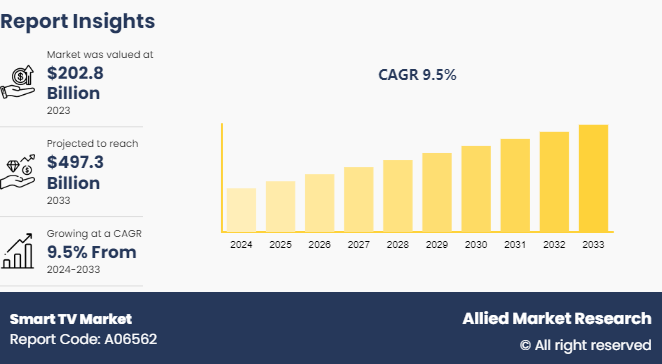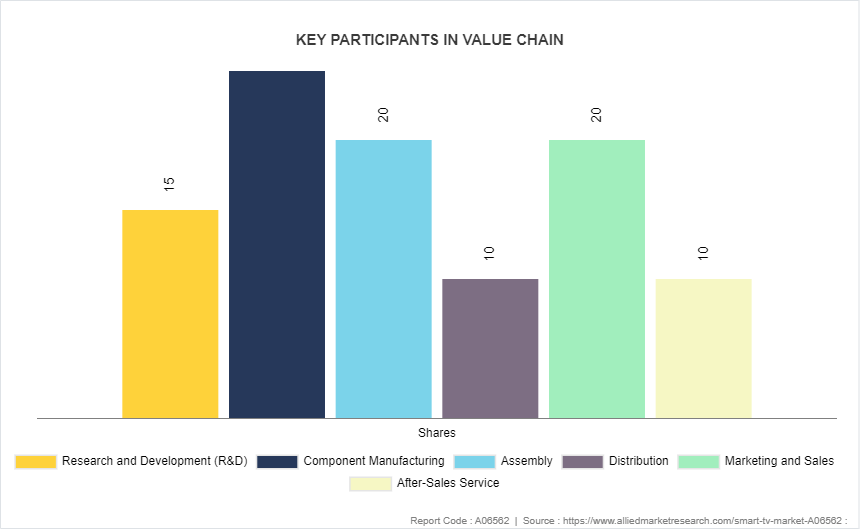Smart TV Market Overview, 2033
The global smart tv market size was valued at $202.8 billion in 2023, and is projected to reach $497.3 billion by 2033, growing at a CAGR of 9.5% from 2024 to 2033. Smart TVs are incorporated with interactive features and internet access in addition to standard broadcast and cable capabilities. Direct web browsing, app access, social networking platform interaction, and streaming video from a variety of online services are all possible with these TVs. With the development of technology, voice recognition, gesture control, and artificial intelligence features are becoming common on smart TVs. The arrival of smart TVs on the market transformed home entertainment by providing consumers with a more connected, personalized, and interactive watching experience than conventional television sets.

Key Takeaways
The smart TVs market study covers 20 countries. The research includes a segment analysis of each country in terms of value for the projected period.
More than 1, 500 product literatures, industry releases, annual reports, and other such documents of major smart TV industry participants along with authentic industry journals, trade associations' releases, and government websites have been reviewed for generating high-value industry insights.
The study integrated high-quality data, professional opinions and analysis, and critical independent perspectives. The research approach is intended to provide a balanced view of global markets and assist stakeholders in making educated decisions to achieve their most ambitious growth objectives.
Key market dynamics
Several significant market aspects influence the growth and development of the smart TV market. Initially, innovation is propelled by technological advancement, as producers consistently improve attributes such as smart capabilities, connectivity, and display quality. Ultra-high-definition TVs (UHD) have become multipurpose entertainment centers due to the emergence of resolutions such as 4K & 8K, internet access, and smart features.
Furthermore, the market for smart TVs is significantly shaped by shifting customer tastes. The need for smart TVs that provide easy access to a vast variety of digital information has increased as streaming services and on-demand content consumption have gained traction. In addition, manufacturers are compelled to develop and differentiate their offers in response to consumer preferences for features such as voice control, smart home integration, and tailored suggestions.
In addition, as tech giants and conventional TV manufacturers compete for market dominance, the level of market rivalry increases the smart tv market share. Well-known companies use their manufacturing ability and brand recognition to launch innovative technologies and broaden their product offerings. To establish momentum in the market, up-and-coming brands concentrate on providing competitive prices and focusing on niche markets.
Moreover, market dynamics are influenced by industry standards and regulatory factors. Regulations about energy efficiency, content licensing, and digital rights management influence how smart TV makers develop their products and approach new markets. Furthermore, new privacy laws about user tracking and data collecting affect how intelligent features and tailored services are implemented.
In addition, smart TV market demands and consumer purchasing behavior are influenced by macroeconomic factors such as demographic changes, economic growth, and levels of disposable income. Owing to rapid urbanization, middle-class population growth, and increased internet connectivity, emerging markets offer substantial development potential.
Owing to technological advancements, shifting customer tastes, market rivalry, macroeconomic changes, and regulatory factors, the smart TV market has emerged as dynamic and competitive. In this rapidly changing industry, manufacturers who predict and adjust to these important market dynamics are anticipated to be in a strong position to take advantage of the opportunities and propel smart tv market growth.
Value Chain Analysis of the Global Smart TV Market
The value chain for the smart TV market consists of several steps, starting with component vendors who supply essential components like processors, connectivity modules, and display panels. After that, manufacturers integrate software platforms and user interfaces onto these parts to create whole smart TV products. Smart TV distribution and sales to customers via online and offline channels are managed by distributors and retailers. To improve user experience, content producers bring apps, streaming services, and multimedia content to smart TV platforms. In addition, installation and after-sales service providers provide smart TV support and maintenance. Collaborations and alliances foster innovation and improve product offerings at every stage of the value chain, creating a smooth environment in which smart TV technology is accessible to and enjoyed by consumers.

Market Segmentation
The smart TV market is segmented into operating system, resolution, screen size, screen shape, distribution channel, technology, and region. On the basis of operating system, the market is categorized into Android TV, Tizen, WebOS, Roku, and Others. Depending on the resolution, it is segregated into 4K UHD TV, HDTV, Full HD TV, and 8K TV. By screen size, the market is classified as Below 32 inches, 32 to 45 inches, 46 to 55 inches, 56 to 65 inches, and above 65 inches. On the basis of screen shape, the market is fragmented into flat and curved. Depending on the distribution channel, the market is bifurcated into online and offline. By technology, the market is divided into OLED, QLED, LED, and others. Region wise, it is studied across North America (U.S., Canada, and Mexico) , Europe (Germany, Spain, UK, Italy, France, Switzerland, and the rest of Europe) , Asia-Pacific (India, China, Japan, Australia, and the rest of Asia-Pacific) , and LAMEA (Latin America, Middle East, and Africa) .
Regional/Country Smart TV Market Outlook
With its strong technological infrastructure, high disposable income, and tech-savvy consumer base, the U.S. continues to lead the global smart TV industry. The U.S. market is still quite competitive as top companies such as Samsung, LG, and Sony always innovate to satisfy customer needs. Furthermore, strategic agreements with content providers such as Netflix have further enhanced smart TVs' allure to American customers. The future of the smart TV market in the U.S. looks bright due to developments in streaming services, display technology, and AI integration. The U.S. market is well-positioned for ongoing expansion and innovation in the smart TV category, as the ease of connected devices drives the growing adoption of smart home ecosystems.
Industry Trends:
In January 2024, Samsung Electronics announced the release of its latest line of smart TVs, which include voice control features and sophisticated AI capabilities for tailored content recommendations.
In May 2023, Sony Corporation and Netflix, the largest streaming service, established a strategic agreement aimed at integrating unique content and improving streaming performance on Sony smart TVs, thus improving the viewing experience for customers.
In February 2024, the Hisense Group disclosed that it had acquired a local company that develops software for smart TVs to fortify its position in the UK market and provide British consumers with improved smart TV features.
In June 2023, in response to the surge in demand from consumers in the UK market for sustainable electronics, Panasonic Corporation unveiled a new range of eco-friendly smart TVs with recyclable materials and energy-efficient screens.
In March 2024, Xiaomi Corporation expanded its line of smart TVs with models that are more affordable and packed with AI-powered voice assistants.
In July 2023, to give customers more entertainment options catered to the Chinese market, Skyworth Group formed strategic alliances with top content providers to improve the content offerings on its smart TV platforms.
In August 2023, LG Electronics announced the expansion of its distribution network in Brazil. The company collaborated with regional retailers to enhance the accessibility of its smart TV products in strategic areas and leverage the growing need for connected home entertainment solutions.
In October 2023, to improve brand awareness and appeal to affluent customers in the Brazilian market, Samsung Electronics unveiled a limited-edition line of high-end smart TVs with unique designs influenced by Brazilian culture.
Competitive Landscape
The major players operating in the smart TV market include Haier Inc., Intex Technologies, Koninklijke Philips N.V., LG Electronics, Panasonic Corporation, Samsung Electronics Co. Ltd, Sansui Electric Co. Ltd, Sony Corporation, TCL Electronics Holdings Limited, Toshiba Solutions, and Hisense International.
Recent Key Strategies and Developments
In September 2022, in India, Samsung introduced its Frame line of smart TVs. To provide immersive entertainment, these TVs come equipped with features like matte display, art mode, and movable bezels.
In May 2021, a 40-inch (100 cm) smart television from OnePlus's Y-series was released on Flipkart. Similar specs to the 43-inch model are found on the new OnePlus Y Series 100 cm (40 inches) Full HD LED Smart Android TV (40FA1A00) . The OnePlus TV 40Y1 is projected to have eight gigabytes of internal storage, a 64-bit processor with 1GB RAM, and 20 W dual speakers with Dolby Audio. With support for Oxygen Play and Gamma Engine, which enhances picture quality and adds dynamic contrast, the device runs Android TV 9.0.
Key Sources Referred
Consumer Technology Association (CTA)
Digital Living Network Alliance (DLNA)
Ultra HD Forum
Smart TV Alliance
The Streaming Video Alliance
Interactive Advertising Bureau (IAB)
Entertainment Software Association (ESA)
Key Benefits For Stakeholders
- This report provides a quantitative analysis of the market segments, current trends, estimations, and dynamics of the smart TV market analysis from 2023 to 2033 to identify the prevailing smart tv market opportunities.
- The market research is offered along with information related to key drivers, restraints, and smart tv market opportunity.
- Porter's five forces analysis highlights the potency of buyers and suppliers to enable stakeholders make profit-oriented business decisions and strengthen their supplier-buyer network.
- In-depth analysis of the smart TV market segmentation assists to determine the prevailing market opportunities.
- Major countries in each region are mapped according to their revenue contribution to the Global market.
- Market player positioning facilitates benchmarking and provides a clear understanding of the present position of the market players.
- The report includes the analysis of the regional as well as Global smart TV market trends, key players, market segments, application areas, and market growth strategies.
Smart TV Market Report Highlights
| Aspects | Details |
| Market Size By 2033 | USD 497.3 Billion |
| Growth Rate | CAGR of 9.5% |
| Forecast period | 2024 - 2033 |
| Report Pages | 250 |
| By Resolution Type |
|
| By Screen Type |
|
| By Application |
|
| By Panel Type |
|
| By Platform |
|
| By Distribution Channel |
|
| By Region |
|
| Key Market Players | Haier Inc., Koninklijke Philips N.V., Hisense International, Toshiba Digital Solutions Corporation, LG Electronics, TCL Electronics Holdings Limited, Sansui Electric Co. Ltd, Samsung Electronics Co. Ltd, Panasonic Corporation, Intex Technologies, Sony Corporation |
| | LG, Electronics Inc., Samsung Electronics Co. Ltd, Sony Corporation, Panasonic Corporation, VIZIO Inc., Xiaomi, Micromax, OnePlus, Apple Inc., Hisense Group Co. Ltd., Koninklijke Philips NV, TCL Corporation, Insignia Systems Inc., Haier Group Corporation, Hitachi Ltd, Westinghouse Electric Corporation |
The global smart TV market is witnessing several emerging trends that are shaping its future. One significant trend is the integration of advanced AI and machine learning technologies, enabling personalized content recommendations and voice-activated controls. Another trend is the growing adoption of 8K resolution screens, offering enhanced picture quality and an immersive viewing experience.
The leading application of the Smart TV market is entertainment, driven by the increasing demand for streaming services and on-demand content. Smart TVs enable users to access a wide range of online platforms such as Netflix, Hulu, Amazon Prime Video, and YouTube, offering an extensive selection of movies, TV shows, and other digital media. Additionally, Smart TVs support gaming applications, social media, and internet browsing, providing a comprehensive multimedia experience.
North America is the largest regional market for Smart TV.
The smart TV market was valued at $202.8 billion in 2023, and is estimated to reach $497.3 billion by 2033, growing at a CAGR of 9.5% from 2024 to 2033.
The major players operating in the smart TV market include Haier Inc., Intex Technologies, Koninklijke Philips N.V., LG Electronics, Panasonic Corporation, Samsung Electronics Co. Ltd, Sansui Electric Co. Ltd, Sony Corporation, TCL Electronics Holdings Limited, Toshiba Solutions, and Hisense International.
Loading Table Of Content...



